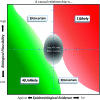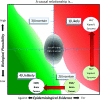Toxicology and epidemiology: improving the science with a framework for combining toxicological and epidemiological evidence to establish causal inference
- PMID: 21561883
- PMCID: PMC3155086
- DOI: 10.1093/toxsci/kfr113
Toxicology and epidemiology: improving the science with a framework for combining toxicological and epidemiological evidence to establish causal inference
Abstract
Historically, toxicology has played a significant role in verifying conclusions drawn on the basis of epidemiological findings. Agents that were suggested to have a role in human diseases have been tested in animals to firmly establish a causative link. Bacterial pathogens are perhaps the oldest examples, and tobacco smoke and lung cancer and asbestos and mesothelioma provide two more recent examples. With the advent of toxicity testing guidelines and protocols, toxicology took on a role that was intended to anticipate or predict potential adverse effects in humans, and epidemiology, in many cases, served a role in verifying or negating these toxicological predictions. The coupled role of epidemiology and toxicology in discerning human health effects by environmental agents is obvious, but there is currently no systematic and transparent way to bring the data and analysis of the two disciplines together in a way that provides a unified view on an adverse causal relationship between an agent and a disease. In working to advance the interaction between the fields of toxicology and epidemiology, we propose here a five-step "Epid-Tox" process that would focus on: (1) collection of all relevant studies, (2) assessment of their quality, (3) evaluation of the weight of evidence, (4) assignment of a scalable conclusion, and (5) placement on a causal relationship grid. The causal relationship grid provides a clear view of how epidemiological and toxicological data intersect, permits straightforward conclusions with regard to a causal relationship between agent and effect, and can show how additional data can influence conclusions of causality.
Figures







Comment in
-
Comments on recent discussions providing differing causation methodologies.Hum Exp Toxicol. 2014 Jan;33(1):109-12. doi: 10.1177/0960327113491511. Epub 2013 Jun 7. Hum Exp Toxicol. 2014. PMID: 23749455 No abstract available.
References
-
- Bayne-Jones S, Burdette W, Cochran W, Farber E, Fieser L, Furth J, Hickam J, LeMaistre C, Schuman L, Seevers M. Smoking and Health: Report of the Advisory Committee to the Surgeon General of the Public Health Service. 1964. Department of Health, Education, and Welfare Public Health Service. Public Health Service Publication No. 1103 Superintendent of Documents. U.S. Government Printing Office,Washington, DC.
-
- Boobis AR, Cohen SM, Dellarco V, McGregor D, Meek ME, Vickers C, Willcocks D, Farland W. IPCS framework for analyzing the relevance of a cancer mode of action for humans. Crit. Rev. Toxicol. 2006;36:781–792. - PubMed
-
- Boobis AR, Doe JE, Heinrich-Hirsch B, Meek ME, Munn S, Ruchirawat M, Schlatter J, Seed J, Vickers C. IPCS framework for analyzing the relevance of a noncancer mode of action for humans. Crit. Rev. Toxicol. 2008;38:87–96. - PubMed
-
- Cohen SM, Meek ME, Klaunig JE, Patton DE, Fenner-Crisp PA. The human relevance of information on carcinogenic modes of action: overview. Crit. Rev. Toxicol. 2003;33:581–589. - PubMed
-
- Colditz GA, Baer HJ, Tamimi RM. Breast cancer. In: Schottenfeld D, Fraumeni JF Jr, editors. Cancer Epidemiology and Prevention. New York: Oxford University Press; 2006.

